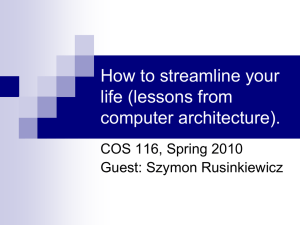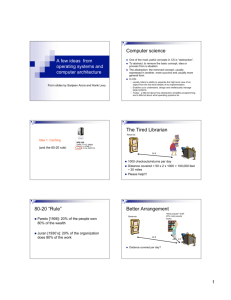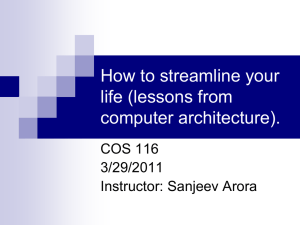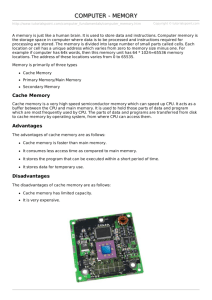How to streamline your life. (Lessons from computer architecture)
advertisement
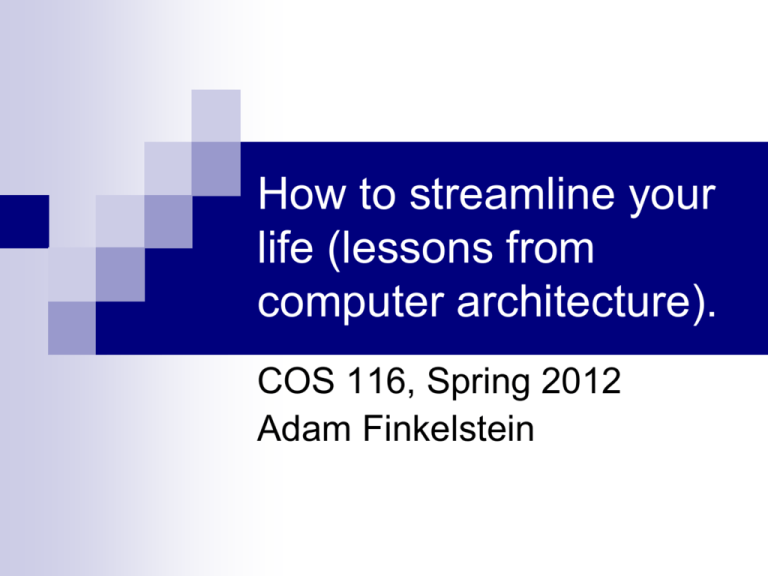
How to streamline your life (lessons from computer architecture). COS 116, Spring 2012 Adam Finkelstein [Bob Warfield] [Jarred Walton] Problem: Retrieval from memory is relatively slow. Solution: “Cache” the tired librarian reserves 100 ft 1000 checkouts or returns per day Distance covered: 100 x 1000 = 100,000 feet ~ 20 miles “80-20 rule” “Pareto principle” Pareto [1906], Juran [1941] 80% of wealth held by 20% of the people 80% of work done by 20% of organization 80% of sales come from 20% of the clients 80% of computer crashes from 20% of bugs 80% of librarian work comes from 20% of books 80% of fetches are for 20% of computer memory better arrangement shelf with 20% most popular books reserves 100 ft 10 ft • Distance covered: 20% (100 x 1000) + 80% (10 x 1000) = 28,000 feet ~ 5 miles even better arrangement shelf with 20% most popular books reserves top 4% (0 ft) 100 ft 10 ft memory cache hierarchy memory cache hierarchy memory cache hierarchy memory cache hierarchy reserves Why this Organization? Speed vs cost of various memories (as of a few years ago) Hard drive Flash (e.g., SSD, USB stick) RAM On-chip memory for CPU (L2 Cache) Cost: $ / GB Speed: GB/s 0.10 0.1 2 0.25 10 10 40000 20 Cache benefit Performance: Speed is close to that of fastest memory (cache) Overall capacity is that of largest memory (disk) encyclopedia assignment 1000 questions like these: What is the capital city of Albania? Who was the fourth Roman Emperor? Who is the prime minister of India? What is the population of Argentina? Which team won the 1968 World Series? …etc. encyclopedia assignment Does cache help? Cache works ok. Needed volume is often at librarian’s desk. Lucky when questions are in same volume. Discussion Time Is the librarian’s problem solved? How to predict the 20% most popular books for next day? In general, no easy solution In practice, use rules of thumb “Least Recently Used”. When you need to create space on the desk (or shelf), move out the book that was used least recently Many others (LRU is computationally expensive) Example: Question How does the same program (.exe file) run on different PCs with different memory configurations? Answer: “Virtual Memory” All programs live a fiction: allowed to pretend they each have 232 or 264 bytes of memory Illusion is preserved by hardware Virtual Memory Program’s view: Lec14.ppt Powerpoint Memory: Address 0 Lec15.ppt Underneath: Address 264 - 1 Lesson 2: Multitasking “The Multitasking Generation” An Evening’s Tasks for a Gen-M’er Homework Listen to music Instant Messaging Call Mom (goes to bed by 11 PM!) Answer phone Read a bit more of Joyce’s Ulysses Watch the Daily Show How do you do it all?!? Tasks done by my PC last night Word processing Play CD Download news updates Download email Run clock Hidden tasks: handle network traffic, manage disk and RAM traffic, scheduler, etc. Managed by “Operating System” (Windows, Linux, MacOS, etc.) Multitasking vs. Parallel Processing Multitasking: A single CPU handles many tasks by switching rapidly among them. (e.g., all Wintel machines since early 1990s; all Unix machines since the 1970s) Parallel Processing: Multiple CPUs that do the work of a single CPU. (But, 4 CPUs do not necessarily mean 4x speed.) Scheduler’s objectives Fairness Timeliness Critical tasks processed promptly Low overhead How can one achieve these (often conflicting) goals?
